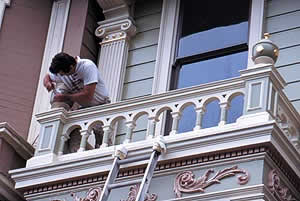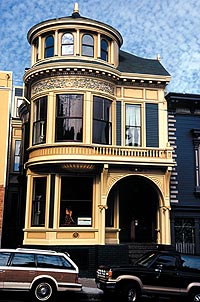
San Francisco Local Color Inc., San Francisco, California
by Amy Johnson
whose motto is “restoring the city one house at a time” has his work cut out for him. But if anyone can do it, it is Bruce Nelson, founder of San Francisco Local Color Inc. Painting and Restoration. Since 1973, Bruce has built an industry-leading company by concentrating on a specialty near and dear to the heart of every San Francisco resident and visitor: the restoration, care, and maintenance of the Bay Area’s Victorians, Edwardians and other fine buildings.
 |
Bruce Nelson with his father, Merritt. |
Nelson’s father was a contractor who worked from a home office, so he learned early on how to run equipment, a crew and a business. After traveling around the world, Nelson joined a friend in San Francisco in 1973 as a house painter, and in a few months went into business for himself. What appealed to him about the San Francisco market? “The beauty of the homes, the sheer number of historic homes and the opportunity to make a statement with color.”
And make a statement he did! The 1970s were marked by a dreadful trend of urban renewal. Countless 19th-century treasures were torn down to make way for less beautiful, less durable new construction. In response, Nelson and like-minded citizens founded the “Color Movement,” painting and restoring these beautiful redwood homes. The more homes they beautified, the more apparent it became that this architecture was a signature of San Francisco. These houses could be art pieces as well as comfortable homes. Destruction was supplanted by preservation.
 |
| Managing supervisor Chris Schneider is also the company's resident expert on applyint gold leaf. |
Today the firm Nelson founded includes his wife, accountant Vicki Frommé; artist, designer and colorist Dean Pearson; managing supervisor Chris Schneider, a twenty-year veteran of the company; and a crew of craftsmen, each with the business at least five years. Together this team brings “antiques” back to their former glory, inside and out, as well as working on custom new construction, mostly in Marin County. They even have a small sub-specialty, refinishing doors.
When it comes to restoring or updating wooden houses, some as old as 130 years and many with ornate details, the work no one sees is the most important. “It always gets back to preparation,” Nelson says. “If there are three things we do well, they are prep, prep, prep.”
 These houses are constructed of old-growth clear-heart redwood that Nelson says will endure for hundreds of years if properly maintained. What it can’t resist is water damage. “Water is traditionally the leading cause of surface degradation and failure, so studying how the water is channeled off a building becomes key. Tightening the building against the ravages of water prevents surface failure, prolongs paint beauty, and protects valuable underlying structures,” he says. San Francisco Local Color works with other trades to suggest repairing or replacing failing gutters, downspouts, porticos, roofs, balconies, flashing, windows, doors, and other wood trim that may channel water. This approach solves the underlying causes of previous paint failures and corrects the problems at their root cause so they do not reoccur. These houses are constructed of old-growth clear-heart redwood that Nelson says will endure for hundreds of years if properly maintained. What it can’t resist is water damage. “Water is traditionally the leading cause of surface degradation and failure, so studying how the water is channeled off a building becomes key. Tightening the building against the ravages of water prevents surface failure, prolongs paint beauty, and protects valuable underlying structures,” he says. San Francisco Local Color works with other trades to suggest repairing or replacing failing gutters, downspouts, porticos, roofs, balconies, flashing, windows, doors, and other wood trim that may channel water. This approach solves the underlying causes of previous paint failures and corrects the problems at their root cause so they do not reoccur.
So the first step of preparation is preventing water damage. The second step is repairing damage that has already occurred. For the past 15 years, Nelson has been replacing rotted wood with a two-part epoxy compound. He says, “Epoxy is the most important restoration tool we have because of its strength and flexibility. It is as strong as the wood around it.” He uses it to restore doors, windowsills, and trim and even to fill gaps and splits in siding. First the rotted wood is cut out. Then a two-part liquid wood consolidant is injected. As it cures over two days, it consolidates the exposed wood fibers. Then the epoxy is mixed and applied, setting in 20 minutes. Nelson prefers products from Wisconsin-based Abatron, experts in restoration materials. Once the material is sanded, it is impossible to tell where the wood ends and the epoxy begins. It takes paint beautifully, weathers well and can be used on concrete and masonry too. Nelson estimates that he can restore wood surfaces and details with this method for about one-tenth the cost of replacing the wood.
|

